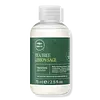What's inside
What's inside
 Key Ingredients
Key Ingredients

 Benefits
Benefits

 Concerns
Concerns

 Ingredients Side-by-side
Ingredients Side-by-side

Water
Skin ConditioningSodium C14-16 Olefin Sulfonate
CleansingSodium Lauryl Sulfate
CleansingCocamidopropyl Hydroxysultaine
CleansingCocamide Mipa
EmulsifyingMelaleuca Alternifolia Leaf Water
AntimicrobialCitrus Limon Fruit Extract
MaskingSalvia Officinalis Extract
AntimicrobialPanthenol
Skin ConditioningSodium Chloride
MaskingPanthenyl Ethyl Ether
Magnesium Nitrate
Glycerin
HumectantCitric Acid
BufferingSodium Hydroxide
BufferingPolyquaternium-10
Disodium EDTA
Magnesium Chloride
Tetrasodium EDTA
Methylchloroisothiazolinone
PreservativeMethylisothiazolinone
PreservativeParfum
MaskingTetramethyl Acetyloctahydronaphthalenes
MaskingHexyl Cinnamal
PerfumingLimonene
PerfumingLinalool
PerfumingCitrus Limon Peel Oil
MaskingWater, Sodium C14-16 Olefin Sulfonate, Sodium Lauryl Sulfate, Cocamidopropyl Hydroxysultaine, Cocamide Mipa, Melaleuca Alternifolia Leaf Water, Citrus Limon Fruit Extract, Salvia Officinalis Extract, Panthenol, Sodium Chloride, Panthenyl Ethyl Ether, Magnesium Nitrate, Glycerin, Citric Acid, Sodium Hydroxide, Polyquaternium-10, Disodium EDTA, Magnesium Chloride, Tetrasodium EDTA, Methylchloroisothiazolinone, Methylisothiazolinone, Parfum, Tetramethyl Acetyloctahydronaphthalenes, Hexyl Cinnamal, Limonene, Linalool, Citrus Limon Peel Oil
Aloe Barbadensis Leaf Juice
Skin ConditioningWater
Skin ConditioningSodium Coco-Sulfate
CleansingSodium Laurylglucosides Hydroxypropylsulfonate
CleansingDecyl Glucoside
CleansingCedrus Atlantica Bark Oil
MaskingCitrus Aurantifolia Oil
CleansingCitrus Aurantium Dulcis Peel Oil
MaskingCitrus Grandis Peel Oil
MaskingCitrus Limon Peel Oil
MaskingLitsea Cubeba Fruit Oil
MaskingCalendula Officinalis Flower Extract
MaskingChamomilla Recutita Flower Extract
MaskingChenopodium Quinoa Seed
AbrasiveCitrus Limon Peel Extract
EmollientStyrax Benzoin Resin Extract
MaskingTocopheryl Acetate
AntioxidantBabassu Oil Polyglyceryl-4 Esters
Bisabolol
MaskingCitric Acid
BufferingCoco-Glucoside
CleansingGlyceryl Oleate
EmollientInulin
Skin ConditioningSodium Chloride
MaskingSodium Phytate
Sodium Sulfate
Alcohol
AntimicrobialBenzyl Alcohol
PerfumingPotassium Sorbate
PreservativeSodium Benzoate
MaskingCitral
PerfumingLimonene
PerfumingAloe Barbadensis Leaf Juice, Water, Sodium Coco-Sulfate, Sodium Laurylglucosides Hydroxypropylsulfonate, Decyl Glucoside, Cedrus Atlantica Bark Oil, Citrus Aurantifolia Oil, Citrus Aurantium Dulcis Peel Oil, Citrus Grandis Peel Oil, Citrus Limon Peel Oil, Litsea Cubeba Fruit Oil, Calendula Officinalis Flower Extract, Chamomilla Recutita Flower Extract, Chenopodium Quinoa Seed, Citrus Limon Peel Extract, Styrax Benzoin Resin Extract, Tocopheryl Acetate, Babassu Oil Polyglyceryl-4 Esters, Bisabolol, Citric Acid, Coco-Glucoside, Glyceryl Oleate, Inulin, Sodium Chloride, Sodium Phytate, Sodium Sulfate, Alcohol, Benzyl Alcohol, Potassium Sorbate, Sodium Benzoate, Citral, Limonene
 Reviews
Reviews

Ingredients Explained
These ingredients are found in both products.
Ingredients higher up in an ingredient list are typically present in a larger amount.
Citric Acid is an alpha hydroxy acid (AHA) naturally found in citrus fruits like oranges, lemons, and limes.
Like other AHAs, citric acid can exfoliate skin by breaking down the bonds that hold dead skin cells together. This helps reveal smoother and brighter skin underneath.
However, this exfoliating effect only happens at high concentrations (20%) which can be hard to find in cosmetic products.
Due to this, citric acid is usually included in small amounts as a pH adjuster. This helps keep products slightly more acidic and compatible with skin's natural pH.
In skincare formulas, citric acid can:
While it can provide some skin benefits, research shows lactic acid and glycolic acid are generally more effective and less irritating exfoliants.
Most citric acid used in skincare today is made by fermenting sugars (usually from molasses). This synthetic version is identical to the natural citrus form but easier to stabilize and use in formulations.
Read more about some other popular AHA's here:
Learn more about Citric AcidCitrus Limon Peel Oil is created from the peels of the lemon. It is used to add a lemon-scent to products. Lemon peel oil also has antibacterial, antifungal, and antioxidant properties. However, it may also cause phototoxicity and sensitize skin.
Lemon peel oil contains limonene, a skin sensitizing ingredient. Another component is furanocoumarin, which induces phototoxicity in skin.
Furanocoumarins bind and destabilize your DNA to increase the rate of sunburn.
Most reputable companies will remove furanocoumarins from their formulations.
Learn more about Citrus Limon Peel OilLimonene is a fragrance that adds scent and taste to a formulation.
It's found in the peel oil of citrus fruits and other plants such as lavender and eucalyptus. The scent of limonene is generally described as "sweet citrus".
Limonene acts as an antioxidant, meaning it helps neutralize free radicals.
When exposed to air, oxidized limonene may sensitize the skin. Because of this, limonene is often avoided by people with sensitive skin.
The term 'fragrance' is not regulated in many countries. In many cases, it is up to the brand to define this term. For instance, many brands choose to label themselves as "fragrance-free" because they are not using synthetic fragrances. However, their products may still contain ingredients such as essential oils that are considered a fragrance.
Learn more about LimoneneChances are, you eat sodium chloride every day. Sodium Chloride is also known as table salt.
This ingredient has many purposes in skincare: thickener, emulsifier, and exfoliator.
You'll most likely find this ingredient in cleansers where it is used to create a gel-like texture. As an emulsifier, it also prevents ingredients from separating.
There is much debate on whether this ingredient is comedogenic. The short answer - comedogenic ratings don't tell the whole story. Learn more about comegodenic ratings here.
The concensus about this ingredient causing acne seems to be divided. Research is needed to understand if this ingredient does cause acne.
Scrubs may use salt as the primary exfoliating ingredient.
Learn more about Sodium ChlorideWater. It's the most common cosmetic ingredient of all. You'll usually see it at the top of ingredient lists, meaning that it makes up the largest part of the product.
So why is it so popular? Water most often acts as a solvent - this means that it helps dissolve other ingredients into the formulation.
You'll also recognize water as that liquid we all need to stay alive. If you see this, drink a glass of water. Stay hydrated!
Learn more about Water